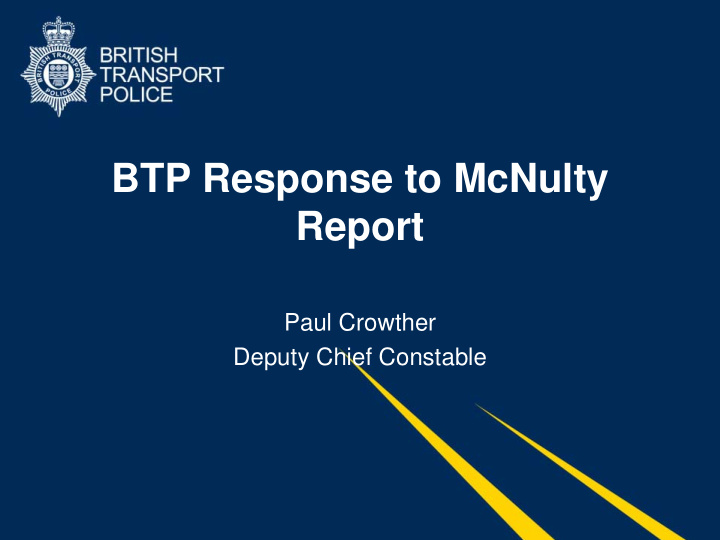



BTP Response to McNulty Report Paul Crowther Deputy Chief Constable
Key McNulty Principles: • GB Rail 30% less efficient then European best in class • Growth in rail transport in future years • The supply chain acting as ‘enablers’ for the rail industry • Developing system wide solutions • The importance of productivity gains as well as savings Key Metrics • Cost per Passenger Kilometre • Cost per Freight Kilometre • Cost per Passenger Pound
Total Passenger Revenue 2004-15 Source: ORR (Rail Trends Handbook 2010-11) and ATOC (Initial Industry Plan 2011) Total Passenger Revenue 9000 8000 7000 6000 £millions 5000 4000 3000 2000 1000 0 2004/05 2005/06 2006/07 2007/08 2008/09 2009/10 2010/11 2011/12 2012/13 2013/14 2014/15 Financial Years
Total Passenger Km 2004-15 Source: ORR (Rail Trends Handbook 2010-11) and ATOC (Initial Industry Plan 2011) Totals by passenger Km 70 60 Passenger Km (bn) 50 40 30 20 10 0 2004/05 2005/06 2006/07 2007/08 2008/09 2009/10 2010/11 2011/12 2012/13 2013/14 2014/15 Financial Years
Total Freight Km 2004-15 Source: ORR (Rail Trends Handbook 2010-11) and ATOC (Initial Industry Plan 2011) Total Freight Km 24 23 22 Freight Km (Bn) 21 20 19 18 17 2004/05 2005/06 2006/07 2007/08 2008/09 2009/10 2010/11 2011/12 2012/13 2013/14 2014/15 Financial Years
Specialist enabling role • Reducing disruption – Cable theft – Fatality Management – Emergency Response Vehicles • Counter terrorism – Bomb threats – Unattended Items • Public order • Olympics • Football and special events
System-wide solutions • Safe, secure, reliable network • BTP potential enabling role – Criminal acts – Inclement weather – Infrastructure failure – Command and control • Co-ordinated system-wide response
BTP real and nominal budget 2004-15 • Between 2008-15 there will be a real term decrease of 11.3% (£194.6m - £172.5m) – Assumes BTP’s budget is standstill followed by RPI for two years – Based on Treasury RPI estimates for 2011-12 and MTFP estimates for 2013-15 BTP real and nominal budget £215.0 £205.0 £195.0 £185.0 £millions £175.0 Nominal terms Real terms £165.0 £155.0 £145.0 £135.0 £125.0 2004-05 2005-06 2006-07 2007-08 2008-09 2009-10 2010-11 2011-12 2012-13 2013-14 2014-15 Financial Years
BTP cost per passenger kilometre 2004-15 • Between 2008-15 there will be a 26% decrease in cost per passenger km – Assumes BTP’s budget is standstill followed by RPI for two years – Based on Treasury RPI estimates for 2011-12 and MTFP estimates for 2013-15 – Source: ORR (Rail Trends Handbook 2010-11) and ATOC (Initial Industry Plan 2011) Cost per passenger km (pence) 0.450 Cost per passenger Km (pence) 0.400 0.350 0.300 0.250 0.200 0.150 0.100 0.050 0.000 2004-05 2005-06 2006-07 2007-08 2008-09 2009-10 2010-11 2011-12 2012-13 2013-14 2014-15 Financial Years
BTP cost per freight kilometre 2004-15 • Between 2008-15 there will be a 19.6% decrease in cost – Assumes BTP’s budget is standstill followed by RPI for two years – Based on Treasury RPI estimates for 2011-12 and MTFP estimates for 2013-15 – Source: ORR (Rail Trends Handbook 2010-11) and ATOC (Initial Industry Plan 2011) Cost per Freight km (pence) 1.100 Cost per Freight km (pence) 1.000 0.900 0.800 0.700 0.600 0.500 0.400 2004-05 2005-06 2006-07 2007-08 2008-09 2009-10 2010-11 2011-12 2012-13 2013-14 2014-15 Financial Year
BTP cost per passenger pound 2004-15 • Between 2008-15 there will be a 15.6% decrease in cost – Assumes BTP’s budget is standstill followed by RPI for two years – Based on Treasury RPI estimates for 2011-12 and MTFP estimates for 2013-15 – Source: ORR (Rail Trends Handbook 2010-11) and ATOC (Initial Industry Plan 2011) Cost per passenger pound (pence) 3.6 Cost per passenger pound 3.4 3.2 3.0 (pence) 2.8 2.6 2.4 2.2 2.0 2004-05 2005-06 2006-07 2007-08 2008-09 2009-10 2010-11 2011-12 2012-13 2013-14 2014-15 Financial Year
Benchmarking • European Benchmarking – Difficult to obtain meaningful data – Dutch Korps Landelijke Politiediensten (KLPD) model • UK (CIPFA POA) Benchmarking – BTP often above average or top quartile – Cost of police officer – Sickness – Number of business support staff per 100 FTE – Priority crime – Victim satisfaction
Determining Optimum Investment • Develop from relative efficiency / VfM • Illustrate return on investment • Link police numbers, crime, confidence and income • HMIC – Adapting to austerity • TfL research • 3% of passenger receipts seen as optimal • Further work commissioned
BTP cost per passenger pound 2004-15 • Between 2008-15 there will be a 15.6% decrease in cost – Assumes BTP’s budget is standstill followed by RPI for two years – Based on Treasury RPI estimates for 2011-12 and MTFP estimates for 2013-15 – Source: ORR (Rail Trends Handbook 2010-11) and ATOC (Initial Industry Plan 2011) Cost per passenger pound (pence) 3.6 Cost per passenger pound 3.4 3.2 3.0 (pence) 2.8 2.6 2.4 2.2 2.0 2004-05 2005-06 2006-07 2007-08 2008-09 2009-10 2010-11 2011-12 2012-13 2013-14 2014-15 Financial Year
Understanding drivers of activity • Primary and secondary drivers mapped • Identified activities associated with drivers • Quality assured through focus groups • Allocated time to each driver • Analysed contribution to reducing disruption • Considered discretionary element • Detailed activity analysis exercise required • Could potentially feed in to Charging Model
Recommend
More recommend